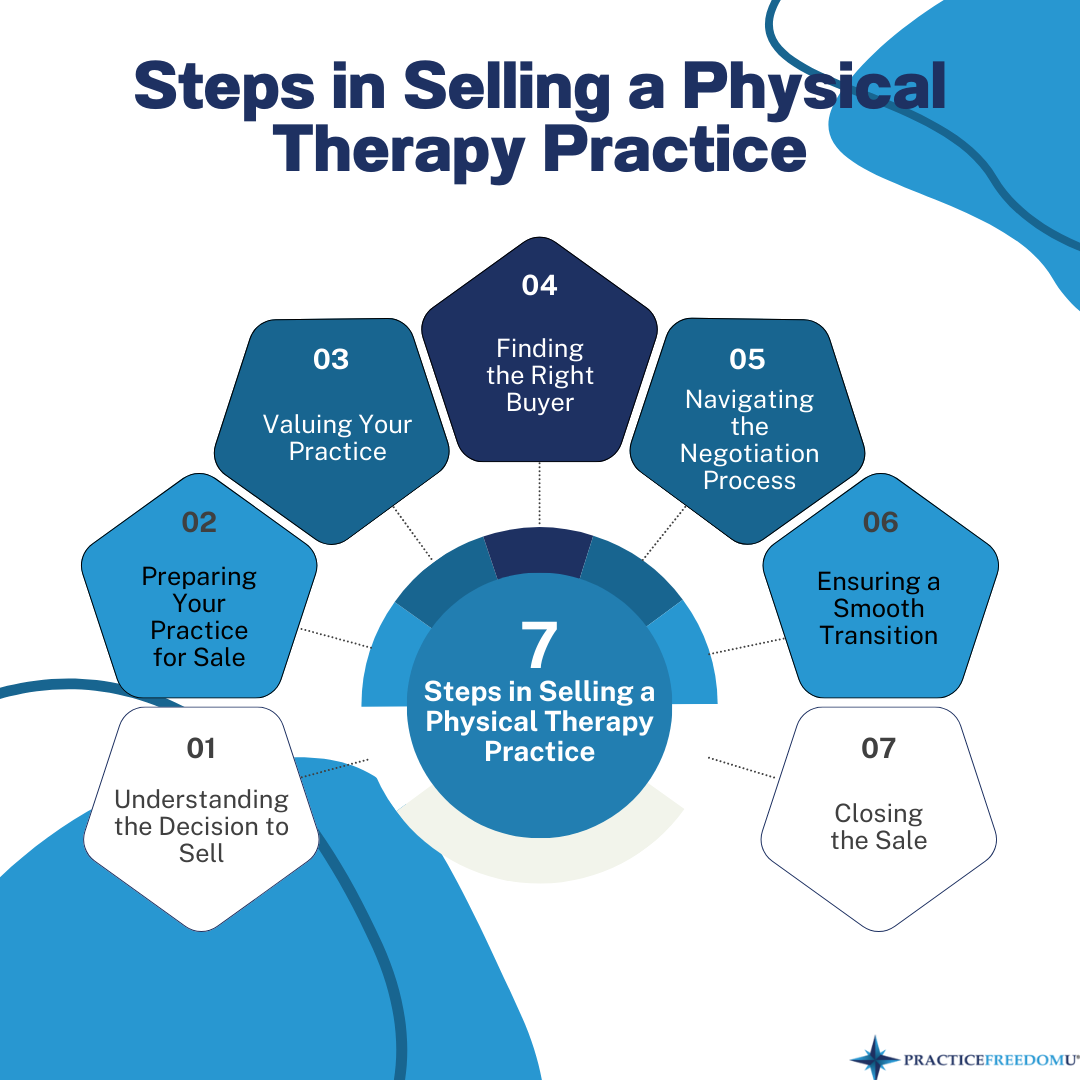The decision to sell a physical therapy practice marks a significant milestone for healthcare professionals. Whether prompted by retirement, career shifts, or personal aspirations, this process demands meticulous planning and strategic execution. It’s essential to navigate the complexities of selling your practice to ensure a smooth transition that secures the best outcome for both the current and incoming owners.
The journey of selling your private practice transcends a mere transaction; it’s a transformation that necessitates preparation and insight. This guide aims to navigate practitioners through the intricacies of the sale, offering insights and strategies for a successful transition.
Understanding the Decision to Sell
Before initiating the sale of your practice, introspection into motivations is crucial. Understanding your motives sets clear objectives and vision. You might find one or more reasons listed below.
- Retirement: A common reason for selling a physical therapy practice is when the owner or primary practitioner is nearing retirement age. After years of dedication and service, they might opt to sell the practice as part of their retirement plans, ensuring a smooth transition while securing the practice’s legacy.
- Career Diversification: Practitioners might choose to sell their practice as they venture into different career paths within or outside the healthcare industry. Exploring new opportunities or interests might lead them to transition away from direct ownership of a physical therapy practice.
- Relocation: Personal reasons like relocating to a different city, state, or country could prompt the sale of a physical therapy practice. Whether for family reasons, lifestyle changes, or personal preferences, practitioners might opt to sell their practice to facilitate the move.
- Health Reasons: In some cases, health concerns or personal health challenges of the owner might lead to the decision to sell the practice. Ensuring the continuity of care and the well-being of patients becomes a priority in such situations.
- Partnership Changes: Shifts in partnership dynamics or disagreements among practice partners might result in the decision to sell the practice. Resolving differences by selling the practice becomes a way to ensure an amicable separation and allow each party to pursue their individual goals.
- Market Conditions: Economic factors, changes in the healthcare landscape, or shifts in the market might influence the decision to sell. Adapting to new market trends or seizing a favorable selling opportunity could prompt the sale of a physical therapy practice.
- Expansion or Growth: Conversely, practitioners might sell their practice to consolidate their efforts or redirect resources into expanding or growing in different areas of healthcare. Selling the practice could provide capital to fuel new ventures or professional endeavors.
- Succession Planning: A carefully thought-out succession plan might involve selling the practice to a new owner or a younger practitioner within the field. This ensures the continuation of the practice’s mission and services while allowing the original owner to step back.
- Burnout or Lifestyle Changes: Overwhelming workloads, burnout, or changes in personal lifestyle preferences might lead to the decision to sell a practice. Prioritizing personal well-being and work-life balance can be a driving force behind this decision.
- Financial Opportunities: At times, an attractive financial offer or an opportunity to capitalize on the value built within the practice might drive the decision to sell. Maximizing financial gains or leveraging an advantageous offer might influence the sale.
Each of these reasons represents diverse motivations that might prompt you to sell your practice, reflecting the multifaceted nature of such decisions within the healthcare industry.
Preparing Your Practice for Sale
Preparing a physical therapy practice for sale requires meticulous planning and highlighting its strengths to attract potential buyers. This phase involves updating crucial documents like financial records and operational agreements, demonstrating the practice’s stability and growth trajectory. Clear communication of the practice’s unique selling points and growth potential further enhances its appeal, making it a compelling investment prospect.
Central to this preparation is the thorough review and update of financial and operational documents. This step solidifies the practice’s credibility, providing transparency and reliability to potential buyers. Beyond documentation, emphasizing the practice’s strengths—whether specialized services or a loyal patient base—alongside presenting its growth story with supporting data, enhances its attractiveness to interested purchasers.
Moreover, implementing proactive strategies, such as refining marketing approaches and diversifying services, elevates the practice’s desirability. These efforts not only expand its reach but also signal adaptability, appealing to buyers seeking a competitive edge. Altogether, these steps position the practice as an appealing and worthwhile investment opportunity within the healthcare sector.
Valuing Your Practice
Determining the value of a physical therapy practice before sale is a pivotal step that requires a comprehensive evaluation of both tangible and intangible assets. It’s a strategic process involving expert consultation and meticulous assessment to arrive at a fair and competitive selling price. Accurately valuing the practice not only sets realistic expectations but also enhances its marketability, ensuring a smooth and profitable transition for both current and incoming owners.
Valuing involves assessing several critical aspects:
- Tangible and Intangible Assets Assessment: Valuing a physical therapy practice encompasses a thorough assessment of both tangible and intangible assets. Tangible assets include physical items like equipment, property, and inventory, while intangible assets encompass goodwill, brand reputation, patient relationships, and intellectual property. Carefully evaluating these assets helps in understanding the practice’s overall worth, shedding light on its strengths and potential areas for enhancement. The blend of tangible and intangible assets forms the essence of the practice’s value, contributing significantly to its attractiveness in the eyes of potential buyers.
- Consulting Experts for Accurate Business Valuation: Seeking expertise from professionals specializing in business valuation plays a crucial role in determining the accurate worth of a physical therapy practice. Business valuators leverage their expertise to assess financial statements, industry trends, market conditions, and various valuation methodologies to arrive at an objective and precise estimation of the practice’s value. Their insights and detailed analysis provide practitioners with a comprehensive understanding of the practice’s position within the market, empowering them to make informed decisions about pricing and negotiations during the sale process.
- Setting a Fair and Competitive Selling Price for your Practice: Setting the selling price for a physical therapy practice requires a delicate balance between maximizing returns and ensuring competitiveness in the market. This step involves integrating the insights derived from asset assessments and expert valuations to determine a fair and competitive price. A well-calibrated selling price not only attracts potential buyers but also reflects the true value of the practice, aligning expectations and enhancing the likelihood of a successful and lucrative sale.Accurately valuing a physical therapy practice involves a multifaceted approach, encompassing asset assessments, expert consultations, and strategic pricing, ensuring that its worth is accurately represented in the market, ultimately leading to a seamless transition of ownership.

Finding the Right Buyer
When it comes to finding the perfect fit for a physical therapy practice, it’s all about a thoughtful and thorough approach. It starts by exploring different avenues to discover potential buyers within the healthcare community. This might mean connecting with fellow professionals, joining industry-specific groups, using online platforms dedicated to practice sales, or simply reaching out to trusted colleagues for recommendations. By casting a wide net, it ensures there’s a diverse pool of potential buyers to consider, offering plenty of options for the practice’s future.
Once potential buyers are identified, the real key is in getting to know them and seeing if they align with the practice’s values and plans. This stage involves genuine conversations and digging into their goals and aspirations for the practice. It’s crucial to evaluate their expertise, resources, and dedication to maintaining the practice’s standards. Working with advisors or business brokers who specialize in healthcare sales can be a game-changer. They bring in-depth knowledge of the industry, a network of potential buyers, and can facilitate smooth negotiations. Their expertise ensures a smooth transition while keeping the practice’s legacy and interests at the forefront.
Navigating the Negotiation Process
When it comes to negotiating the sale of your practice, it’s about finding that balance between securing a good outcome and creating a deal that works well for everyone involved. It all starts with open and thorough discussions covering everything from the sale terms to the price and any conditions related to the transition. Being clear about these details builds trust and reduces the chances of misunderstandings, laying a solid foundation for a successful sale. The ultimate aim is to create an agreement that respects the practice’s value and meets the needs of both the seller and the buyer.
Getting legal and financial experts on board is crucial at this stage. These professionals, well-versed in practice sales and acquisitions, bring invaluable guidance. Legal advisors navigate the complexities of contracts, ensuring that everyone’s interests are protected within the agreement’s terms. Meanwhile, financial experts provide insights to structure the deal fairly, assess its value, and manage the financial side of the sale. Their expertise offers clarity on regulations, financial impacts, and procedural details, smoothing out the negotiation process and safeguarding the practice’s integrity through the transition.
Ensuring a Smooth Transition
Navigating the transition of ownership in a physical therapy practice demands meticulous planning and seamless coordination. From developing comprehensive transition plans to fostering effective communication and collaboration, the process requires careful orchestration to maintain the practice’s stability and ensure uninterrupted patient care.
- Developing a Comprehensive Transition Plan: Create a detailed plan for staff, patient management, operations, and finances to ensure a clear and smooth transition of ownership.
- Strategies for Communication During the Handover: Maintain open and transparent communication among all involved parties to minimize uncertainty and align everyone during the ownership transfer.
- Collaborating for a Seamless Transfer of Ownership: Work together between outgoing and incoming owners to navigate challenges and ensure stability, prioritizing patient care continuity.
During the ownership transition, careful planning, open communication, and teamwork pave the way for a smooth handover. This method protects the practice’s values and dedication to uninterrupted patient care, signifying a successful shift and an exciting new phase ahead.
Closing the Sale and Moving Forward
Finalizing the sale of your practice marks a significant milestone, wrapping up legalities and transactions. This phase demands meticulous attention to legal documents and financial settlements, ensuring a smooth and legally sound transition of ownership. It’s a moment to celebrate the achievement, reflecting on the practice’s legacy and the contributions made while nurturing it—a sense of closure and accomplishment as you move forward.
Entering the post-sale phase unlocks new possibilities and ventures. It’s a time to embrace change and explore fresh opportunities in healthcare. This transition offers room for personal and professional growth, bidding adieu to one chapter while welcoming an exciting journey ahead. Experiences gained from your previous practice can ignite innovation and pave the way for success in the evolving healthcare industry. Approaching this phase with enthusiasm and adaptability sets the stage for continuous growth and accomplishments beyond the sale’s completion.
Selling a private practice is a multifaceted process requiring foresight, preparation, and execution. Understanding motivations, meticulous preparation, finding the right buyer, navigating negotiations, ensuring a smooth transition, and finalizing the sale pave the way for a successful transition while embracing new opportunities.
——————————————–
Are you ready for a coach? Join the hundreds of physical therapy owners who are building the practice of their dreams with the support, guidance and direction of a Practice Freedom U Coach. Take the first step towards creating a business that sets you free by scheduling a Discovery Call


